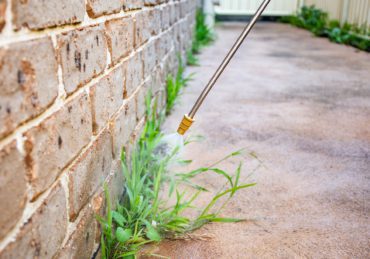Dethatching is the essential process of removing excessive layers of organic matter, known as thatch, from lawns. This buildup can impede grass growth by obstructing air, water, and nutrient access, ultimately affecting overall lawn health. Thatch layers thicker than ½ inch for warm-season grasses and ⅓ inch for cool-season grasses can suffocate roots and promote pests and diseases. Regular dethatching not only encourages healthier grass growth but also enhances resilience against environmental stressors. Understanding the intricacies of dethatching benefits and processes can greatly improve your lawn’s health and appearance. Uncover more about the timing and methods to optimize your lawn care.
Why is Dethatching Important?
Dethatching is imperative for maintaining a healthy lawn, as excessive thatch can obstruct important resources like air, water, and nutrients.
By effectively removing this layer, lawn care promotes improved grass growth and resilience, while minimizing the risk of pests and diseases.
Understanding the benefits of dethatching and the dangers of accumulated thatch is essential for achieving long-term lawn vitality.
The Benefits of Removing Thatch
Removing thatch is essential for maintaining a healthy lawn, as it directly improves access to air, water, and nutrients for grass roots.
Dethatching alleviates the adverse effects of a thick thatch layer, which can exceed ½ inch for warm-season grasses or ⅓ inch for cool-season varieties. A dense thatch layer can suffocate roots, hinder water absorption, and create an environment conducive to pests and diseases.
Regular dethatching not only enhances water absorption but also promotes superior airflow and root strength, increasing resilience against drought, weeds, and pests.
Ultimately, effective dethatching contributes to improved soil quality and nutrient availability, fostering a robust lawn ecosystem that supports long-term lawn health and liveliness.
Risks of Excess Thatch
Excess thatch poses significant risks to lawn health, as it can suffocate grass roots and impede crucial access to water, air, and nutrients. A thatch layer thicker than 1 inch creates a barrier that restricts moisture penetration and nutrient absorption, leading to weakened grass and unhealthy lawns.
According to lawn care experts, this excessive buildup can also foster conditions favorable for pests and diseases, complicating maintenance efforts and increasing the likelihood of grass die-off. Furthermore, signs of excess thatch include water runoff during rainfall and a spongy lawn texture, indicating poor root establishment.
Regular dethatching is essential for addressing these issues, ensuring lawns remain resilient against drought, weeds, and pests while promoting overall vitality and health.
When to Dethatch Your Lawn
Determining the ideal timing for dethatching is crucial for maintaining a healthy lawn.
Cool-season grasses should ideally be dethatched in early spring or late summer to early fall, while warm-season grasses benefit most from dethatching in late spring to early summer.
Understanding these timelines will enhance the recovery and health of your lawn.
Best Timing for Cool-Season Grasses
When is the ideal time to dethatch cool-season grasses to guarantee maximum recovery and health?
The best timing for dethatching occurs during early spring and late summer to early fall. During these periods, cool-season grasses are actively growing, allowing them to recover effectively from the stress of dethatching.
It is essential to monitor the thatch layer, as a thickness exceeding 3/4 inch indicates the need for this important process.
Dethatching during dormancy or extreme stress can severely damage the grass, hindering its recovery and health.
To enhance results, consider combining dethatching with core aeration, which improves water and nutrient penetration into the soil, promoting a healthier lawn overall.
Best Timing for Warm-Season Grasses
The ideal timing for dethatching warm-season grasses is during late spring to early summer, ensuring the grass is in its peak growing phase for best recovery.
It is essential to dethatch your lawn when the thatch layer exceeds 1 inch, as excessive thatch can impede water and nutrient absorption, compromising overall lawn health.
Performing dethatching during the active growth period allows the grass to recover swiftly and effectively.
Avoid undertaking this process during dormancy or stress, as it can lead to significant damage and poor recovery outcomes.
Furthermore, combining dethatching with aeration during this period enhances the benefits of both practices, promoting a healthier lawn and fostering peak growth through robust healthy lawn care strategies.
How to Dethatch Your Lawn
To effectively dethatch your lawn, selecting the appropriate tools is crucial.
Manual rakes are suitable for small areas with light thatch, while power equipment is recommended for larger spaces or significant thatch buildup.
Understanding the differences between these options will guarantee a more efficient and effective dethatching process.
Tools for Dethatching
Using the appropriate tools for dethatching is crucial for effectively managing thatch buildup and promoting a healthy lawn.
For small areas, a dethatching rake is ideal, featuring sharp tines that efficiently pull up light thatch.
In contrast, electric dethatchers serve medium-sized lawns, handling mild to moderate thatch issues with ease, typically available for rental at about $75 to $80.
For larger areas with severe thatch, power rakes are recommended; they function similarly to mowers, utilizing rotating blades and costing around $80 for rental.
Furthermore, vertical mowers, or verticutters, are specifically designed for thick thatch removal and provide adjustable depths, making them suitable for both dethatching and overseeding efforts.
Selecting the right tool guarantees the best lawn health.
Using a Manual Rake vs. Power Equipment
When deciding between a manual rake and power equipment for dethatching, it is crucial to take into account the size of the lawn and the severity of thatch buildup.
A manual rake is ideal for small lawns or light thatch issues, providing precise control while minimizing damage to the grass.
Conversely, power equipment, such as power rakes, is designed for larger areas or severe thatch layers, operating similarly to mowers with rotating tines that expedite the dethatching process.
For thick thatch layers exceeding 2 inches, professional-grade vertical mowers may be necessary.
Regardless of the tool chosen, verify that the tines penetrate sufficiently to reach the thatch layer without scalping healthy grass, particularly when the lawn is slightly moist.
After Dethatching: Essential Lawn Care Tips
Post-dethatching care is essential for restoring lawn health and ensuring robust grass growth. Dethatching helps eliminate the thatch layer, but it is important to follow up with proper maintenance.
Begin by raking up the debris to promote a cleaner lawn, and consider composting the material for extra nutrients.
Next, water your lawn deeply, ensuring it receives 1-1.5 inches of water within the week to support grass recovery.
Aeration can further enhance soil structure, allowing for better nutrient and water penetration.
Furthermore, applying a high-quality fertilizer is critical; opt for a slow-release product to nourish your grass effectively.
Preventing Thatch Buildup
Preventing thatch buildup requires a proactive approach to lawn care, focusing on regular maintenance practices.
Key strategies include the use of aeration to enhance soil health and the careful management of mowing and fertilization techniques.
Regular Lawn Care Practices
Regular lawn care practices are essential for maintaining a healthy turf and preventing the accumulation of thatch, which can negatively impact grass vigor.
One effective strategy is to limit watering to 1-1.5 inches per week, guaranteeing deep watering 2-3 times to encourage robust root growth without promoting excessive top growth.
Furthermore, using low-nitrogen or slow-release fertilizers minimizes organic material buildup that contributes to thatch.
Regular mowing, adhering to the one-third rule, prevents stress on grass and discourages thatch formation.
Annual aeration improves soil structure and mitigates compaction, further reducing the risk of thatch.
Aeration vs. Dethatching
Understanding the differences between aeration and dethatching is essential for effectively managing lawn health and preventing thatch buildup.
Dethatching specifically targets the removal of thick layers of organic material, known as thatch, which can impede grass growth.
In contrast, aeration alleviates soil compaction, enabling better water and nutrient absorption. By creating holes in the soil, aeration enhances root growth and improves overall soil structure, thereby reducing the chances of thatch accumulation.
Both practices should ideally be performed during the growing season for best results.
When used together, aeration can enhance the effectiveness of dethatching, allowing grass to recover more effectively from the removal of thatch, ultimately promoting a healthier lawn.
Should You Hire a Professional?
When faced with significant thatch buildup, particularly when layers exceed 2 inches, DIY methods may not suffice.
Hiring a professional can guarantee the use of specialized equipment and expertise, mitigating the risk of damaging the lawn during the dethatching process.
Furthermore, professionals often incorporate complementary services, enhancing overall lawn health and vigor.
When DIY Might Not Be Enough
Homeowners should consider hiring a professional for dethatching when thatch layers exceed 2 inches, as excessive buildup can severely compromise grass health.
The decision to dethatch depends on the extent of the thatch problem and the lawn’s condition.
Professionals possess specialized equipment that can efficiently address significant thatch issues while ensuring that the proper depth settings are maintained to avoid damaging grass roots.
This expertise not only saves homeowners time and effort, especially on larger properties, but also allows for the integration of additional lawn care services, such as aeration and fertilization.
Engaging professionals can lead to tailored solutions that optimize long-term lawn health and aesthetics, making it a wise choice for homeowners facing severe thatch challenges.




